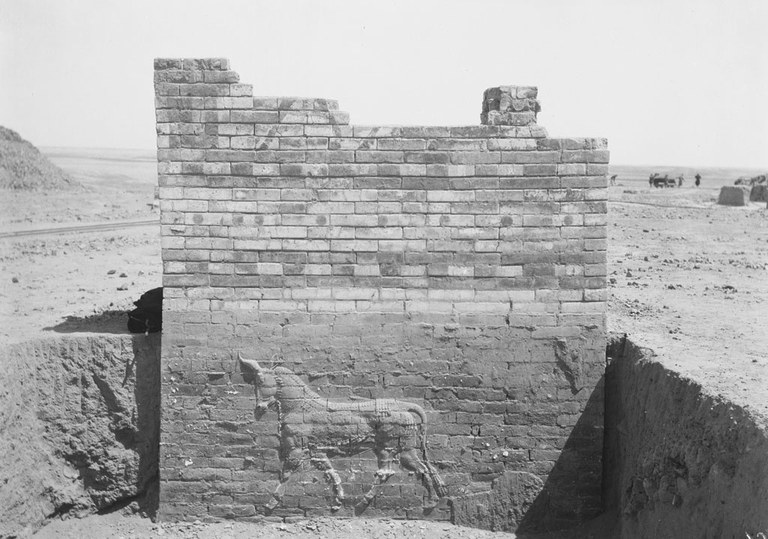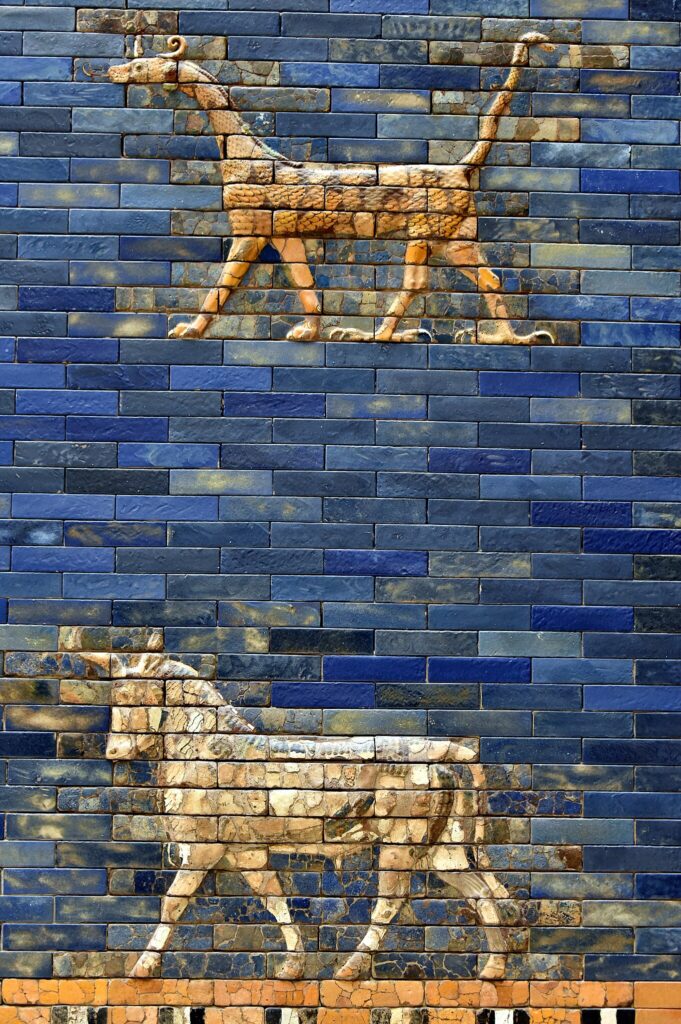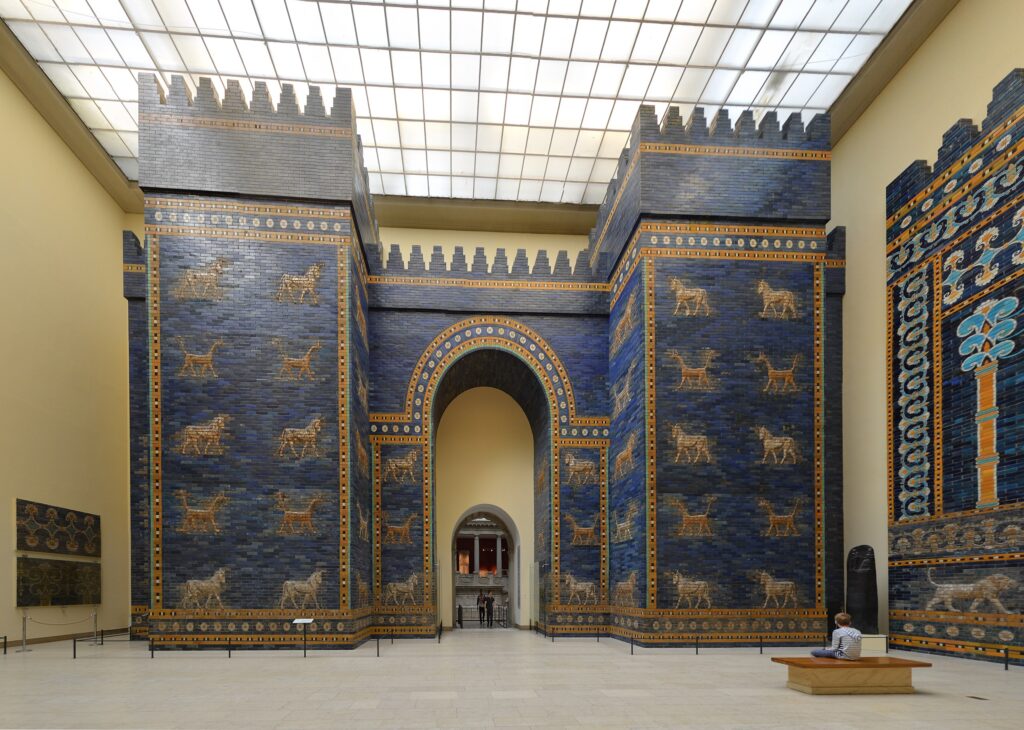Indus Valley Civilization: Echoes of a Forgotten Past
Nestled in the plains of present-day Pakistan and northwest India lies one of the world’s most enigmatic ancient societies: the Indus Valley...
Maya M. Tola 28 August 2025
The Ishtar Gate, one of the most iconic remnants of Ancient Mesopotamia, stands as a testament to the grandeur of the cradle of civilization. This striking cobalt-blue structure, with its intricate reliefs and vibrant colors, not only symbolizes the artistic mastery and architectural ingenuity of the Babylonians but also their profound cultural, religious, and political significance. As a monumental entrance to the ancient city of Babylon, the gate exemplifies the fusion of art and power, representing the divine authority of the gods and the strength of the Babylonian empire at its height.
Nestled between the Tigris and Euphrates rivers, Babylon (modern-day Iraq) was one of the most influential cities of the ancient world. Ancient texts from Herodotus to the Old Testament describe the city’s overwhelming opulence, with magnificent temples, shrines, and palaces that exemplified Babylon’s grandeur and divine favor. At its peak, Babylon was home to over 200,000 inhabitants, making it the largest and most sophisticated metropolis of its time. The Ishtar Gate was one of the eight monumental gates of the city, providing a ceremonial entry to the inner sanctum of Babylon and standing as a grand tribute to the goddess Ishtar.

Views of the ruins near the Ishtar gate in 1932, Library of Congress, Washington, DC, USA. Wikimedia Commons (public domain).
As part of a grand rebuilding project, Nebuchadnezzar II transformed Babylon in the 6th century BCE, adorning the city’s structures with vibrant glazed bricks in shades of blue, red, and yellow. The Ishtar Gate, standing over 38 ft (11.5 m) tall, was constructed around 575 BCE.
Commissioned by Nebuchadnezzar II, the gate was not just an architectural marvel but also a powerful declaration of royal authority. Built during one of Babylon’s most glorious phases, the Ishtar Gate quickly became an enduring symbol of the city’s splendor, attracting visitors even in antiquity who marveled at its monumental size and intricate craftsmanship.

Portion of an Ishtar Gate wall found in situ in 1902, Staatliche Museen zu Berlin, Berlin, Germany. Photograph by Olaf M. Teßmervia.
The Ishtar Gate was built in dedication to Ishtar, the powerful goddess of love, war, and fertility, who was a prominent member of the Mesopotamian divine pantheon known as the Anunnaki. Revered as a deity of dualities, Ishtar was worshipped primarily for her roles in love and war, with her influence extending to fertility, political power, and even thunderstorms. Her multifaceted nature made her an essential figure in both the personal and political spheres of Babylonian life.
Additionally, Ishtar was associated with food preservation and the protection of granaries, cementing her importance as a guardian of both spiritual and economic well-being. The grandeur of the Ishtar Gate was, in part, a reflection of her immense cultural and religious significance to the Babylonians.

The Queen of the Night (the Burney relief), ca. 1800–1750 BCE, British Museum, London, UK.
In ancient Babylon, art and architecture were deeply intertwined with religious devotion, serving as both cultural expressions and acts of piety. The Ishtar Gate, constructed with enameled bricks of cobalt blue and sea green, is adorned with reliefs of dragons and bulls, symbols of the city’s grandeur and divine favor.
The Processional Way leading to the gate was lined with walls of glazed brick reliefs, showcasing remarkable detail and a dynamic sense of movement. Lions, sacred to Ishtar, in regal procession, symbolizing her divine protection and strength as well also other reliefs featuring striding bulls, representing the storm god Adad, and mušḫuššu, dragon-like creatures associated with the city’s chief deity, Marduk are depicted.

Detail of aurochs from the Ishtar Gate, Pergamon Museum, Berlin, Germany. Photograph by Osama Shukir Muhammed Amin via Wikimedia Commons (CC-BY-SA-4.0).
The use of polychrome glazed bricks was a groundbreaking innovation in Babylonian architecture, turning structures into vivid, visual narratives. These colors were achieved through the precise firing of mineral-based glazes, resulting in a luminous effect that has withstood the test of time. The technical expertise behind these bricks highlights the peak of Mesopotamian craftsmanship, reflecting the Babylonians’ mastery in material science and artistic expression.

Replica of the Ishtar Gate in 2016, Hilla, Iraq. Photograph by Babil Hilla via Flicker.
In 1899, German archaeologists began excavating the ancient city of Babylon, and by 1902, they had unearthed the Ishtar Gate, which stood precisely where it was expected, marking the entrance to the city at the beginning of Procession Street.
Despite significant damage during the 2003 Iraq War, a partial reconstruction of the Ishtar Gate, based on the original excavations by Robert Koldewey, is now displayed at the Pergamon Museum in Berlin, Germany. While the original gate remains in ruins in Iraq, the reconstruction offers modern viewers a chance to experience the historical grandeur of one of ancient Babylon’s most iconic structures. In the 1980s, Saddam Hussein’s regime reconstructed a two-thirds-size replica of the Ishtar Gate.

Ishtar Gate at Pergamon Museum in Berlin, Germany. Photograph by Radomir Vrbovsky via Wikimedia Commons (CC-BY-SA 4.0).
The Ishtar Gate continues to captivate and inspire artists, historians, and travelers worldwide. It serves as a passage into an ancient city where art and architecture were not only expressions of cultural identity but also powerful statements of devotion and authority. Recognized for its grandeur, the gate was celebrated by Antipater of Sidon, a Greek poet from the 2nd century BCE, who included it as one of the Seven Wonders of the Ancient World. This distinction made Babylon the only city to claim two sites on the list, alongside the Hanging Gardens of Babylon, further solidifying the gate’s enduring legacy as a symbol of ancient splendor.
DailyArt Magazine needs your support. Every contribution, however big or small, is very valuable for our future. Thanks to it, we will be able to sustain and grow the Magazine. Thank you for your help!